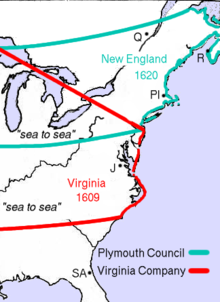Council for New England
The Council for New England was a public company in 1620 by a charter of the British Crown , was assigned the area of New England in North America to colonize.

The council received the settlement rights in the area that was previously part of the Colony of Virginia and was north of the 40th parallel and extended to the 48th parallel. Thus the area along the Atlantic coast between Long Island and the Bay of Fundy . The Council for New England was dissolved in 1635 following the establishment of Plymouth Colony , Massachusetts Bay Colony , Province of New Hampshire , Saybrook Colony, and New Haven Colony .
The shareholders of the company consisted of members of the landed gentry and merchants. The president was Sir Ferdinando Gorges . His plan was to divide the land into mansion areas and fiefs among the other 40 members. In this way, a monolithic, aristocratic Anglican province was to emerge, organized according to English land law. They gave the rest of the land, along with local self-government rights, to other individuals or groups, although those recipients remained under the authority of the Governor General of the Council. These colonies were to be administered by members of the gentry from Plymouth, Exeter and Bristol. The members of the council were to be granted permanent rights and privileges for the conduct and administration of the colony's trade, including for their descendants.
The plan failed, the colonization of New England was carried out by two other companies, the Plymouth Colony, which was founded in 1620 and whose settlers settled on Cape Cod , and the Massachusetts Bay Colony which was founded in 1629. Both received their grants from the Council for New England. These settlers changed the character of New England settlements. Contrary to the ideas of the council, which had a single aristocratic and Anglican province in mind, a patchwork of small, independent, medium-sized Puritan and separatist colonies was created.
Through a charter from King Charles I , the Massachusetts Bay Colony was able to untangle the tangled land titles and resolve conflicting lines of political authority. So she initially served the Council for New England as an intermediary.
Under the leadership of the Council for New England, the Plymouth Colony, New Hampshire State, Massachusetts Bay Colony, and New Haven Colony were established.
The company's shareholders were:
- Ludovic Stewart, 2nd Duke of Lennox (1574-1624)
- George Villiers, 1st Duke of Buckingham (1592–1628)
- William Herbert, 3rd Earl of Pembroke (1580-1630)
- Thomas Howard, 21st Earl of Arundel (1585-1646)
- William Alexander, 1st Earl of Stirling (around 1567-1640)
- James Hamilton, 2nd Marquess of Hamilton (1589-1625)
- Henry Wriothesley, 3rd Earl of Southampton (1573-1624)
- Robert Rich, 2nd Earl of Warwick (1587–1658)
- John Ramsay, 1st Earl of Holderness (around 1580–1626)
- Edward la Zouche, 11th Baron Zouche (1556-1626)
- Edmund Sheffield, 1st Baron Sheffield (1521-1549)
- Baron Gorges of Dundalk (1582-1650)
- Robert Carr, 1st Earl of Somerset (around 1586–1645)
- Robert Mansell (around 1570–1652)
- Edward Zouch († 1634)
- Dudley Digges (1583-1639)
- Thomas Roe (around 1581–1644)
- Ferdinando Gorges (around 1568–1647)
- Francis Popham (1573-1644)
- John Brooke, 1st Baron Cobham (1575-1660)
- Richard Hawkins (1562-1622)
- Allen Apsley (1567-1630)
- Warwick Hale
- Richard Catchmay
- John Bourchier
- Nathaniel Rich (1585-1636)
- Edward Giles (1566-1637)
- Giles Mompesson (around 1583–1663)
- Thomas Wroth (1584–1672)
- Matthew Sutcliffe (around 1550-1629)
- Robert Heath
- John Drake (around 1556-1628)
- Raleigh Gilbert
- George Chudley
- Thomas Hamon
- John Argall
Individual evidence
- ^ A b Francis Newton Thorpe: The Charter of New England: 1620. In: yale.edu. avalon.law.yale.edu, 1998, accessed July 26, 2020 .
- ^ Francis Newton Thorpe: The Act of Surrender of the Great Charter of New England to His Majesty: 1635. In: yale.edu. avalon.law.yale.edu, 1998, accessed July 26, 2020 .
- ^ A b Council for New England - United States history. In: britannica.com. Encyclopedia Britannica, accessed July 26, 2020 .
- ^ Council for New England - Encyclopedia.com. In: encyclopedia.com. Retrieved July 26, 2020 .
Web links
- Charter of 1620 in the Avalon Project
- The Act of Surrender of the Great Charter of New England to His Majesty: 1635 in the Avalon Project